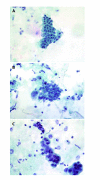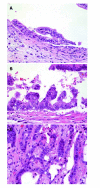Suspicious brush cytology is an indication for liver transplantation evaluation in primary sclerosing cholangitis
- PMID: 28970730
- PMCID: PMC5597506
- DOI: 10.3748/wjg.v23.i33.6147
Suspicious brush cytology is an indication for liver transplantation evaluation in primary sclerosing cholangitis
Abstract
Aim: To investigate markers for high-grade dysplasia for the optimal timing of liver transplantation in patients with primary sclerosing cholangitis (PSC).
Methods: Earlier data support a dysplasia-carcinoma sequence, even low- to high-grade dysplasia, in PSC-associated cholangiocarcinoma (CCA). Surveillance using endoscopic retrograde cholangiography (ERC) and brush cytology aims to detect cases of biliary dysplasia, and liver transplantation is an option in cases with suspicion of malignancy in brushing. This study investigated markers to identify patients with high-grade biliary dysplasia for optimal timing in early liver transplantation. Patients undergoing surveillance using ERC and brush cytology during 2008-2014 and who were diagnosed with biliary dysplasia in explanted liver or CCA until February 2016 were included in the study. Demographic data, cholangiography findings, laboratory values, cytological morphology and DNA ploidy were analysed.
Results: Thirty PSC patients had biliary neoplasia in the explanted liver during the study period. Sixteen of these patients had low-grade dysplasia, 10 patients had high-grade dysplasia, and 4 patients had CCA. Fifteen PSC patients diagnosed with CCA were not transplanted. Patients with low-grade dysplasia were younger. Alkaline phosphatase or carcinoembryonic antigen values did not differ between groups during surveillance, but carbohydrate antigen 19-9 was higher in CCA patients. No difference in PSC duration, ERC scores, suspicious cytology, or ploidy analysis was found between groups. No difference was observed between fibrosis stage in explanted livers. Low- and high-grade dysplasia could not be differentiated before liver transplantation based on liver enzymes, tumour markers, ERC scores, brush cytology or DNA ploidy.
Conclusion: Repeated suspicion of neoplasia in brush cytology should be an indication for evaluations of liver transplantation prior to the development of CCA.
Keywords: Biliary dysplasia; Brush cytology; Cholangiocarcinoma; Endoscopic retrograde cholangiography.
Conflict of interest statement
Conflict-of-interest statement: We have no financial relationships to disclose.
Figures


Similar articles
-
Screening primary sclerosing cholangitis and biliary dysplasia with endoscopic retrograde cholangiography and brush cytology: risk factors for biliary neoplasia.Endoscopy. 2016 May;48(5):432-9. doi: 10.1055/s-0041-110792. Epub 2016 Jan 25. Endoscopy. 2016. PMID: 26808393
-
Surveillance of primary sclerosing cholangitis with ERC and brush cytology: risk factors for cholangiocarcinoma.Scand J Gastroenterol. 2017 Feb;52(2):242-249. doi: 10.1080/00365521.2016.1250281. Epub 2016 Nov 3. Scand J Gastroenterol. 2017. PMID: 27806633
-
Diagnostic performance of a stepwise cytological algorithm for biliary malignancy in primary sclerosing cholangitis.Liver Int. 2019 Feb;39(2):382-388. doi: 10.1111/liv.14007. Epub 2018 Dec 2. Liver Int. 2019. PMID: 30507030
-
Screening and diagnosis of cholangiocarcinoma in patients with primary sclerosing cholangitis.Rev Gastroenterol Disord. 2009 Spring;9(2):E41-7. Rev Gastroenterol Disord. 2009. PMID: 19668124 Review.
-
Metal, magnet or transplant: options in primary sclerosing cholangitis with stricture.Hepatol Int. 2018 Nov;12(6):510-519. doi: 10.1007/s12072-018-9906-6. Epub 2018 Nov 14. Hepatol Int. 2018. PMID: 30430358 Review.
Cited by
-
Role of Endoscopy in Primary Sclerosing Cholangitis.Clin Endosc. 2021 Mar;54(2):193-201. doi: 10.5946/ce.2020.019-IDEN. Epub 2020 May 8. Clin Endosc. 2021. PMID: 32380796 Free PMC article. Review.
-
Cholangiocarcinoma in Patients with Primary Sclerosing Cholangitis (PSC): a Comprehensive Review.Clin Rev Allergy Immunol. 2020 Feb;58(1):134-149. doi: 10.1007/s12016-019-08764-7. Clin Rev Allergy Immunol. 2020. PMID: 31463807 Review.
-
Liver Transplantation for Primary Sclerosing Cholangitis (PSC) With or Without Inflammatory Bowel Disease (IBD)-A European Society of Organ Transplantation (ESOT) Consensus Statement.Transpl Int. 2023 Sep 29;36:11729. doi: 10.3389/ti.2023.11729. eCollection 2023. Transpl Int. 2023. PMID: 37841645 Free PMC article.
-
Genetic alterations during the neoplastic cascade towards cholangiocarcinoma in primary sclerosing cholangitis.J Pathol. 2022 Nov;258(3):227-235. doi: 10.1002/path.5994. Epub 2022 Sep 6. J Pathol. 2022. PMID: 35897137 Free PMC article.
References
-
- Claessen MM, Vleggaar FP, Tytgat KM, Siersema PD, van Buuren HR. High lifetime risk of cancer in primary sclerosing cholangitis. J Hepatol. 2009;50:158–164. - PubMed
-
- Lewis JT, Talwalkar JA, Rosen CB, Smyrk TC, Abraham SC. Precancerous bile duct pathology in end-stage primary sclerosing cholangitis, with and without cholangiocarcinoma. Am J Surg Pathol. 2010;34:27–34. - PubMed
-
- Boyd S, Tenca A, Jokelainen K, Mustonen H, Krogerus L, Arola J, Färkkilä MA. Screening primary sclerosing cholangitis and biliary dysplasia with endoscopic retrograde cholangiography and brush cytology: risk factors for biliary neoplasia. Endoscopy. 2016;48:432–439. - PubMed
-
- Boyd S, Mustonen H, Tenca A, Jokelainen K, Arola J, Färkkilä MA. Surveillance of primary sclerosing cholangitis with ERC and brush cytology: risk factors for cholangiocarcinoma. Scand J Gastroenterol. 2017;52:242–249. - PubMed
MeSH terms
Substances
LinkOut - more resources
Full Text Sources
Other Literature Sources
Medical

